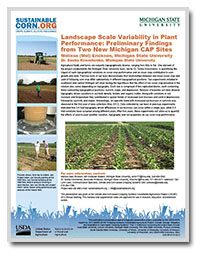Landscape
 |
Project intern Joe Devota planting in a field in Michigan. |
Agricultural fields and farms are naturally diverse, ranging from hilly to flat. One element of this project is quantifying the impact of variations of the landscape on cover crop performance and on cover crop contribution to corn growth and yield.
Previous work of our team members demonstrates that relationships between red clover cover crop and yield of a following corn crop differ substantially in different topographical positions. Data collected by our team in previous experiments indicated that 3-4 fold topography-driven differences in rye biomass can occur within a single year, while 2-3 fold variations have occurred among different years. After five years, these experiments will allow us to quantify the effects of year-to-year weather variation, topography and soil properties on rye cover crop performance.
Resources:
 |
|
| Speed Science: Landscape Scale Variability in Plant Performances: Preliminary Findings from Two Sites in Michigan | Mel Erickson, graduate student at Michigan State University, talks about how topography affects plant growth. This presentation was made at this project's 2012 annual conference. |
